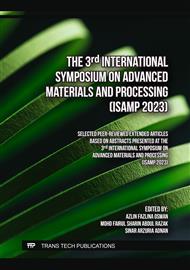[1]
M. Thariq et al., Biocomposite Materials Design and Mechanical Properties Characterization Composites Science and Technology. 2021. [Online]. Available: http://www.springer.com/series/16333
Google Scholar
[2]
N. Herlina Sari, I. N. G. Wardana, Y. S. Irawan, and E. Siswanto, "Characterization of the Chemical, Physical, and Mechanical Properties of NaOH-treated Natural Cellulosic Fibers from Corn Husks," J. Nat. Fibers, vol. 15, no. 4, p.545–558, 2018.
DOI: 10.1080/15440478.2017.1349707
Google Scholar
[3]
N. Mallegni, T. V. Phuong, M. B. Coltelli, P. Cinelli, and A. Lazzeri, "Poly(lactic acid) (PLA) based tear resistant and biodegradable flexible films by blown film extrusion," Materials (Basel)., vol. 11, no. 1, 2018.
DOI: 10.3390/ma11010148
Google Scholar
[4]
M. B. Coltelli, N. Mallegni, S. Rizzo, P. Cinelli, and A. Lazzeri, "Improved impact properties in poly(lactic acid) (PLA) blends containing cellulose acetate (CA) prepared by reactive extrusion," Materials (Basel)., vol. 12, no. 2, 2019.
DOI: 10.3390/ma12020270
Google Scholar
[5]
S. Su, R. Kopitzky, S. Tolga, and S. Kabasci, "Polylactide (PLA) and its blends with poly(butylene succinate) (PBS): A brief review," Polymers (Basel)., vol. 11, no. 7, p.1–21, 2019.
DOI: 10.3390/polym11071193
Google Scholar
[6]
Y. Wang et al., "Improved fracture toughness and ductility of PLA composites by incorporating a small amount of surface-modified helical carbon nanotubes," Compos. Part B Eng., vol. 162, no. October 2018, p.54–61, 2019.
DOI: 10.1016/j.compositesb.2018.10.060
Google Scholar
[7]
A. N. Frone, S. Berlioz, J. F. Chailan, and D. M. Panaitescu, "Morphology and thermal properties of PLA-cellulose nanofibers composites," Carbohydr. Polym., vol. 91, no. 1, p.377–384, 2013.
DOI: 10.1016/j.carbpol.2012.08.054
Google Scholar
[8]
Ulyarti, Nazarudin, and D. W. Sari, "The study of functional properties of Nypa fruticans flour," AIP Conf. Proc., vol. 1823, 2017.
DOI: 10.1063/1.4978100
Google Scholar
[9]
P. Tamunaidu, N. Matsui, Y. Okimori, and S. Saka, "Nipa (Nypa fruticans) sap as a potential feedstock for ethanol production," Biomass and Bioenergy, vol. 52, no. 0, p.96–102, 2013.
DOI: 10.1016/j.biombioe.2013.03.005
Google Scholar
[10]
K. Tsuji et al., "Biological and ethnobotanical characteristics of Nipa Palm (Nypa fructicans wurmb.): A review," Sains Malaysiana, vol. 40, no. 12, p.1407–1412, 2011.
Google Scholar
[11]
V. Govindan, S. Husseinsyah, and T. P. Leng, "Treated Nypa fruticans Husk-filled Regenerated Cellulose Biocomposite Films," BioResources, vol. 11, no. 4, p.8739–8755, 2016.
DOI: 10.15376/biores.11.4.8739-8755
Google Scholar
[12]
R. Tong, G. Chen, J. Tian, and M. He, "Highly transparent, weakly hydrophilic and biodegradable cellulose film for flexible electroluminescent devices," Carbohydr. Polym., vol. 227, no. September 2019, 2020.
DOI: 10.1016/j.carbpol.2019.115366
Google Scholar
[13]
M. Poletto, H. L. Ornaghi Júnior, and A. J. Zattera, "Native cellulose: Structure, characterization and thermal properties," Materials (Basel)., vol. 7, no. 9, p.6105–6119, 2014.
DOI: 10.3390/ma7096105
Google Scholar
[14]
S. Adnan, A. H. Azhar, L. Jasmani, and M. F. Samsudin, "Properties of paper incorporated with nanocellulose extracted using microbial hydrolysis assisted shear process," IOP Conf. Ser. Mater. Sci. Eng., vol. 368, no. 1, 2018.
DOI: 10.1088/1757-899X/368/1/012022
Google Scholar
[15]
U. D. Akpabio et al., "Preparation of Pulp and Cellulose Acetate from Nypa Palm Leaves," Int. J. Environ. Bioenergy, vol. 2012, no. 3, p.179–194, 2012, [Online]. Available: www.ModernScientificPress.com/Journals/IJEE.aspx
Google Scholar
[16]
T. C. Mokhena, J. S. Sefadi, E. R. Sadiku, M. J. John, M. J. Mochane, and A. Mtibe, "Thermoplastic processing of PLA/cellulose nanomaterials composites," Polymers (Basel)., vol. 10, no. 12, 2018.
DOI: 10.3390/polym10121363
Google Scholar
[17]
Y. Dong, A. Ghataura, H. Takagi, H. J. Haroosh, A. N. Nakagaito, and K. T. Lau, "Polylactic acid (PLA) biocomposites reinforced with coir fibres: Evaluation of mechanical performance and multifunctional properties," Compos. Part A Appl. Sci. Manuf., vol. 63, p.76–84, 2014.
DOI: 10.1016/j.compositesa.2014.04.003
Google Scholar
[18]
S. B. ROY, D. S. C. SHIT, D. R. A. SEN GUPTA, and D. P. R. SHUKLA, "A Review on Bio-Composites: Fabrication, Properties and Applications," Int. J. Innov. Res. Sci. Eng. Technol., vol. 03, no. 10, p.16814–16824, 2014.
DOI: 10.15680/ijirset.2014.0310058
Google Scholar
[19]
T. Gurunathan, S. Mohanty, and S. K. Nayak, "A review of the recent developments in biocomposites based on natural fibres and their application perspectives," Composites Part A: Applied Science and Manufacturing, vol. 77. p.1–25, 2015. doi: 10.1016/j.compositesa. 2015.06.007.
DOI: 10.1016/j.compositesa.2015.06.007
Google Scholar
[20]
R. A. Ilyas and S. M. Sapuan, "Biopolymers and Biocomposites: Chemistry and Technology," Curr. Anal. Chem., vol. 16, no. 5, p.500–503, 2020.
DOI: 10.2174/157341101605200603095311
Google Scholar
[21]
N. Mohd Nurazzi, A. Khalina, S. M. Sapuan, A. H. A. M. Dayang Laila, M. Rahmah, and Z. Hanafee, "A review: Fibres, polymer matrices and composites," Pertanika J. Sci. Technol., vol. 25, no. 4, p.1085–1102, 2017.
Google Scholar
[22]
M. Jawaid and H. P. S. Abdul Khalil, "Cellulosic/synthetic fibre reinforced polymer hybrid composites: A review," Carbohydr. Polym., vol. 86, no. 1, p.1–18, 2011.
DOI: 10.1016/j.carbpol.2011.04.043
Google Scholar
[23]
V. Beloshenko, Y. Voznyak, A. Voznyak, and B. Savchenko, "New approach to production of fiber reinforced polymer hybrid composites," Compos. Part B Eng., vol. 112, p.22–30, 2017.
DOI: 10.1016/j.compositesb.2016.12.030
Google Scholar
[24]
M. R. Kaiser, H. B. Anuar, N. B. Samat, and S. B. A. Razak, "Effect of processing routes on the mechanical, thermal and morphological properties of PLA-based hybrid biocomposite," Iran. Polym. J. (English Ed., vol. 22, no. 2, pp.123-131,2013.
DOI: 10.1007/s13726-012-0112-4
Google Scholar
[25]
G. V. Prasanna and K. V. Subbaiah, "Hardness , tensile properties and morphology of blend hybrid biocomposites," vol. 2, no. May, p.21–29, 2013.
Google Scholar
[26]
A. Valdés et al., "Characterization and enzymatic degradation study of poly(ε-caprolactone)-based biocomposites from almond agricultural by-products," Polym. Degrad. Stab., vol. 132, p.181–190, 2016.
DOI: 10.1016/j.polymdegradstab.2016.02.023
Google Scholar
[27]
S. Momeni et al., "The effect of poly (Ethylene glycol) emulation on the degradation of pla/starch composites," Polymers (Basel)., vol. 13, no. 7, p.1–19, 2021.
DOI: 10.3390/polym13071019
Google Scholar
[28]
M. S. Rasidi, L. C. Cheah, and A. M. Nasib, "Mechanical Properties and Biodegradability of Polylactic Acid/Acrylonitrile Butadiene Styrene with Cellulose Particle Isolated from Nypa Fruticans Husk," Int. J. Automot. Mech. Eng., vol. 17, no. 4, p.8351–8359, 2020.
DOI: 10.15282/ijame.17.4.2020.11.0631
Google Scholar
[29]
N. Hegyesi, Y. Zhang, A. Kohári, P. Polyák, X. Sui, and B. Pukánszky, "Enzymatic degradation of PLA/cellulose nanocrystal composites," Ind. Crops Prod., vol. 141, no. August, p.111799, 2019.
DOI: 10.1016/j.indcrop.2019.111799
Google Scholar



